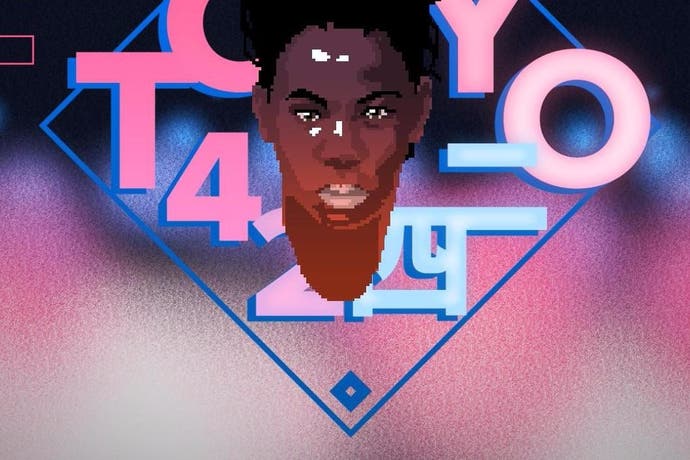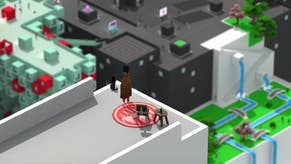Tokyo 42 review
Tokyo storeys.
Voila: The Die Hard Mission. Not that it's called that. I can't remember what it's called, but anyway, like a lot of Tokyo 42's missions - and that is not a criticism - this one sees you infiltrating a skyscraper to get the guy at the top. The skyscraper is called the Nakatomi building, and that's enough of a cue for how to approach things. You're massively outmatched, of course. Goons on every floor. So as you advance, you have to be stealthy, which in Tokyo 42, if not in Die Hard, means using the katana: sneaking up behind people and slicing them before they know you're there. But at the top of the building - Tokyo 42 does not do interiors very frequently, so every structure in the game is covered with exterior walkways you navigate to move up and down - katanas won't really cut it anymore. You have to ride the penthouse elevator right into an ambush.
So what would McClane do? He would have options here: save points are common to encourage experimentation, and there's a loaded weapon wheel to pick from, although nothing in amongst the sniper rifles and rocket launchers will come as much of a surprise. Despite all this, it is a wrench to be forced from the shadows. Tokyo 42's wider design suggests a game built around freewheeling open-world adventure. It's at its best, though, when it settles into a different groove: stealth and precision. Stealth and precision, and the occasional moment where you have to leap into the unknown.
Tokyo 42 is a dreamlike action game. You move across bright, toytown landscapes with a wonderfully dreamy gait, executing dreamy, easy to maneuver jumps from one building to another, and occasionally exchanging volleys of dreamy, easy to navigate gunfire - if such a thing is possible - when everything goes wrong. Crucially, this dreaminess doesn't feel like a problem. It's not one of those games where everything feels floaty and lacking in impact. Rather, it's the old Jack Reacher chestnut: you write the slow things fast and the fast things slow. In Tokyo 42, the action would normally be too fast to make sense of. Rather than opting for bullet-time, the developer drops a few Valium and the whole thing finds its own pace. Slowed, for sure, but wonderfully precise with it.

The story is pretty streamlined. It's the near future and pharmaceutical companies - if I have been following this correctly - have rendered death a minor distraction. You play as a hired gun, exploring a world of conspiracy and corruption, one faction mission at a time. The video game maths is strong: Tokyo 42 blends the original GTA, ditching the cars, with a little Syndicate and something of Crackdown in its compact, chunky, endlessly promising cityscape. No fall damage to speak of here, and plenty of sci-fi tricks. You can track people with catbots. You can change disguises at the press of a button to blend in with the crowd if you have enough in-game energy. You can dive from the highest rooftop, hit the streets and pretty much vanish.
Despite some characterful moments along the way, the city is the real emphasis. What a place: brightly coloured dream architecture ranging from thuggish Gothic cathedrals and blossom-blown temples through to Mondrian apartment complexes that look like something hard and plastic a toddler might lose down the back of a sofa. Gaudi is represented and so is Bauhaus. The crowds are dinky but readable, and they're the best in-game throngs since Jet Set Radio Future: dandies, hipsters, scenesters, the odd streaker. The pills that have removed a lasting death - if I have been following this correctly - have also dropped the world into a prolonged arrested development.
If the city is a big plastic toy, shorn, except for a few notably wobbly instances, of interiors, it just about works because of the often wonderfully - and often infuriatingly - unusual camera choice. Tokyo 42 offers an isometric view of proceedings seen from surveillance-drone height. As you move around the game's bright, cleanly drawn spaces, you can rotate the camera, almost a la Fez, shunting it through a series of set angles with prods of the shoulder buttons. So as you advance up the floors of that Nakatomi building, as you move around the corners, heading higher and higher, you'd better be moving the camera as you go as well, shifting it in increments so you're always in the frame, and you always know what's coming your way. You're both the agent and the agent's spotter. At times like this it feels empowering, and also makes you feel responsible for your own failures. The times I lost a firefight at Nakatomi were because I was staring into the blank wall of an apartment block that was covering my view of the action - and I was staring at that wall because I didn't think fast enough. Sometimes, though, towards the end of the game, there are missions in purposefully hard-to-glimpse spaces, and it can seem, during these moments, as if some of the challenge is emerging from an intentional desire to make the camera a bit of an enemy. These missions are not Tokyo 42's best.

In truth, all-out action is rarely that much fun here. Your two methods of aiming weapons are both imperfect - an easy point-and-shoot option that doesn't allow you to adapt to the height of the terrain (or is far too fiddly when you dip into the menus to allow it to adapt to the height of the terrain), and something more complicated for lining up long distance or precision shots that's just a bit too sluggish for the standard pace of play. Meanwhile, enemy AI, such as it is, tends to make up for its inadequacies with overwhelming force, which means you'd better get a lot done before you trigger any alarms.
Happily, for most of the campaign - save a few survive-the-wave sequences - you're allowed and encouraged to stealth it out, to move thoughtfully, and thin the ranks of your enemies one at a time as you push in on your eventual target or your objective, which could be standard fare like shooting couriers or planting detonators. In-game stat-tracking makes it clear that you want to be working invisibly or thoroughly or - ideally - invisibly and thoroughly.
Stealth is also the approach that gets the best out of those wonky enemy behaviours. As an example, a maze sequence makes your foe's limitations stand out very clearly. Guards on the brink of spotting you will forget you the moment you leave their eyeline. And you will leave their eyeline when their patrol path pulls them away from something they should probably be focused on. It's not a highlight of the experience, in other words, but clear UI that shows when you're about to be spotted does at least make the whole thing predictable and even gameable - not a bad compromise given that this is, you know, a game. Zig and zag and you can often evade even a muddle of potential attackers who simply can't remember what they have seen. I know this strategy isn't optimal, but I did abuse it quite shamelessly in the trickier moments and I have no regrets.
Besides, all of this means that multiplayer shines. Deathmatch is the only mode available at the moment, although the menu UI always made me feel I was missing something. Either way, this is wonderful stuff, a bunch of you blending into the crowd as you try to work out which members of the madding throng are other players and, by extension, your enemies. This is where those catbots come in, slinking through the masses and rubbing up against anyone who doesn't quite fit. I love the way this approach to deathmatch subverts multiplayer basics. It's a twitchy delight that values observation and attention to detail over trigger skills.
Whichever way you play Tokyo 42, I reckon it all comes back to that location rather than the things you often do in it. It is a pleasure to explore a game that looks like this, a pleasure to pull out seamlessly to the map and witness a beautiful chunky paradise of colour and shape nestled in the clouds. Outside of the campaign and the generous side-missions, the city is a bit of a puzzle as you work out how to reach its most far-flung areas. Crucially, there is life everywhere you look. For all the mayhem, Tokyo 42 is a celebration of urban living: gatherings in parks, people having a quiet rooftop barbecue, mats rolled out for an open-air yoga class.
Tokyo 42 is often a great Die Hard game, and a decent enough Syndicate or GTA heir. But its best mode of play is probably the one that's hidden in the menu: a treasure hunt where you scour the city to work through a list of cryptic clues related to features of the landscape that require spotting and tagging. This is an I,Spy game writ large and - simultaneously - writ very small. I am more than willing to put up with duff enemies and a fiddly camera to spend more time in a space like this.













